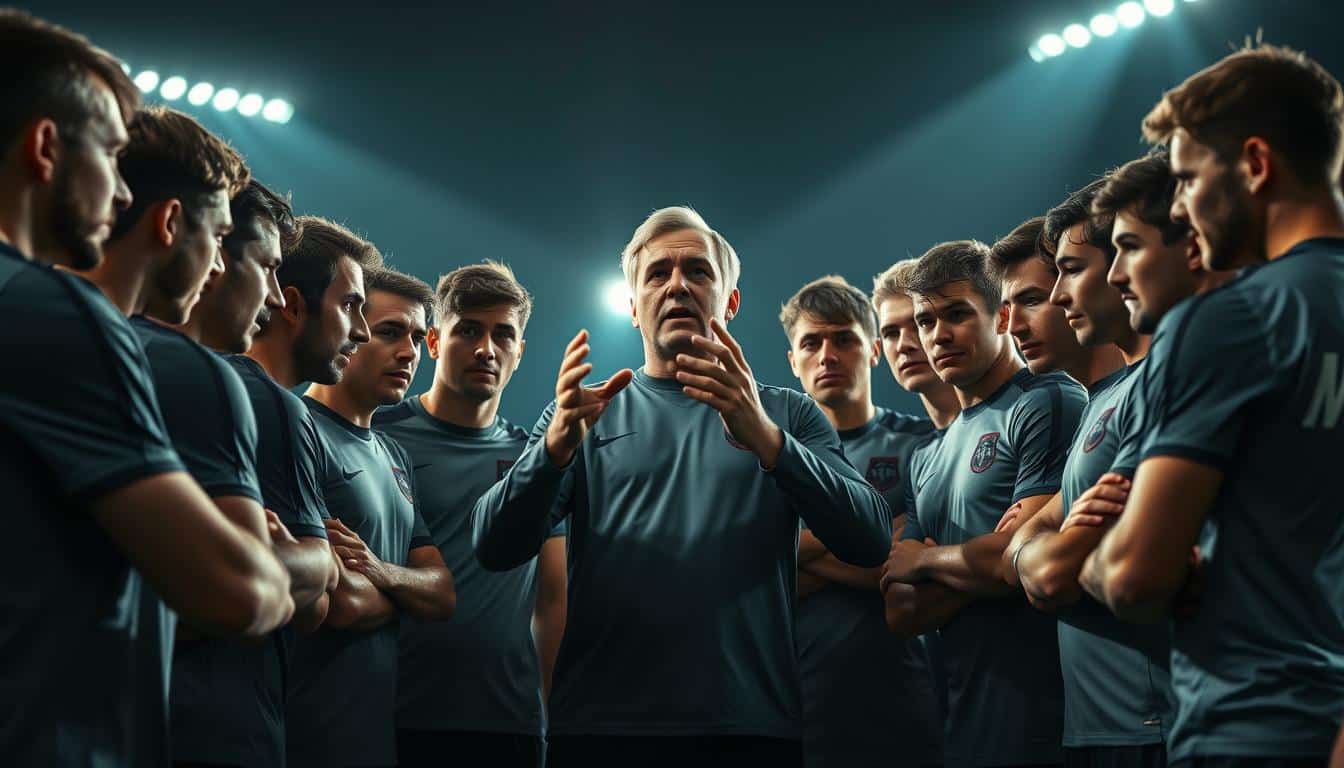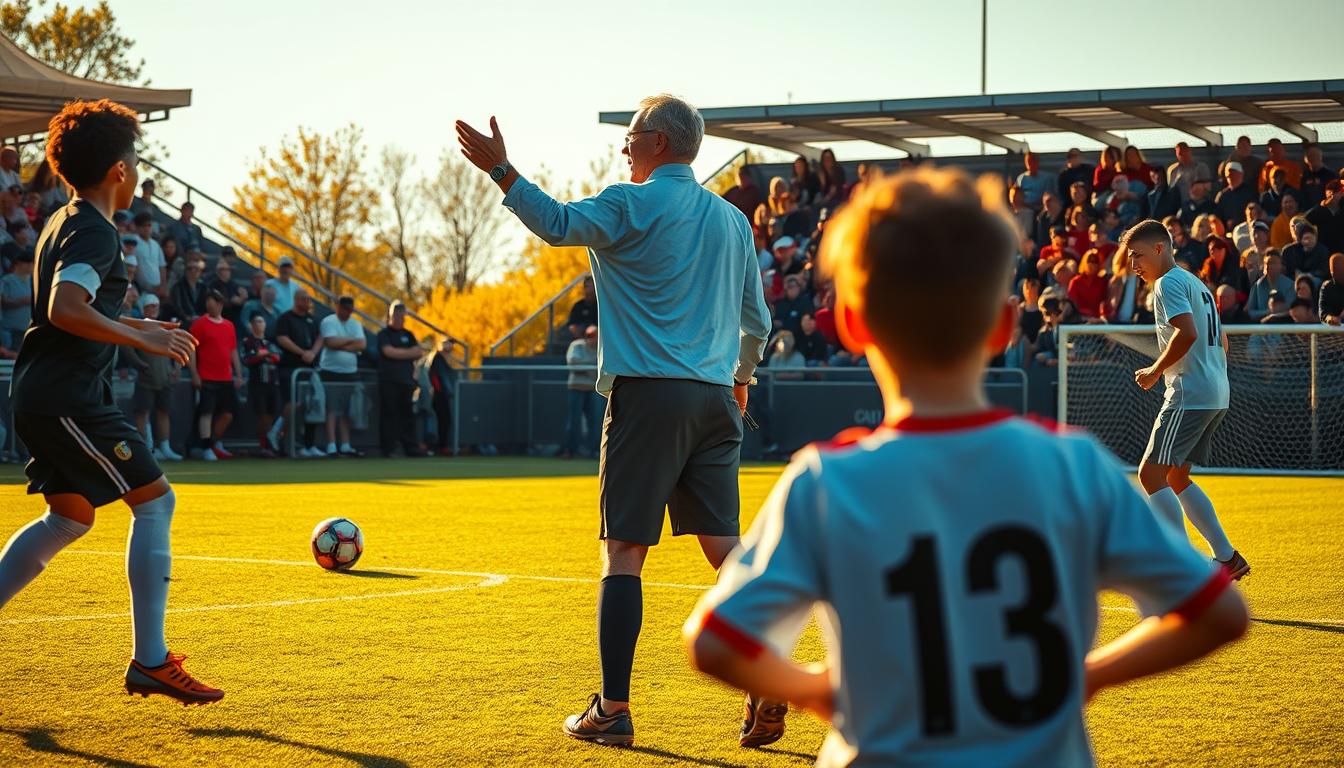Motivation Tips for Soccer Teams

Ever wonder why some squads dominate week after week while others fizzle out? The answer lies in player drive – the invisible force that transforms talented groups into unstoppable forces. Whether you’re guiding a youth league or coaching high-level athletes, unlocking consistent performance starts with understanding what makes teams tick.
Championship-caliber units don’t rely on skill alone. They create environments where athletes push boundaries even when exhausted. The best coaches use tailored approaches – celebrating personal milestones while fostering collective grit. From pre-game rituals to post-loss reflections, these methods keep squads hungry through grueling seasons.
Key Takeaways
- Consistent drive separates temporary wins from lasting success
- Balanced approaches work better than one-size-fits-all strategies
- Effective methods address both individual and group dynamics
- Proven techniques help athletes overcome physical/mental slumps
- Investment in player development yields season-long results
Discover how top programs maintain peak performance levels through strategic engagement methods. We’ll break down actionable approaches used by leading mentors across competitive leagues – tools you can adapt immediately for your roster.
Understanding Motivation in Soccer
Unlocking peak performance requires tapping into what fuels your roster. Drive comes from two engines: personal ambition and group dynamics. Mastering this balance turns average squads into forces that outlast opponents.
The Two Engines of Player Drive
Internal fire starts with personal connections to the game. Athletes might chase personal records or relish the thrill of competition. These self-driven goals create lasting commitment that weathers tough seasons.
External catalysts come from your coaching toolkit. Recognition systems and collaborative drills build environments where effort becomes contagious. When these forces align, squads develop grit that shows in crunch time.
How Fueled Squads Outperform
Groups with balanced drive display:
- Faster bounce-backs after losses
- Consistent practice intensity
- Shared leadership during challenges
You’ll notice fewer missed sessions and more players staying late to refine techniques. Communication sharpens as teammates anticipate each other’s moves. This cohesion translates to smarter decisions when the scoreboard matters most.
Setting Clear and Achievable Goals
Clear targets transform potential into progress. When athletes know exactly what they’re chasing, every drill and match becomes purposeful. The magic happens when you blend immediate challenges with visionary aims.
Creating Short-Term Targets
Start with stepping-stone objectives that show quick wins. Maybe boost passing accuracy by 15% in three weeks or cut defensive errors by two per game. These bite-sized milestones build confidence while sharpening skills.
Use numbers and deadlines to track growth. Players thrive when they see weekly stats improving. It turns abstract effort into visible results they can celebrate.
Defining Long-Term Objectives
Bigger ambitions need roadmap planning. Aim for playoff qualification or perfecting a counterattack style by season’s end. Break these into monthly checkpoints to maintain momentum.
Review targets every six weeks. If half your roster masters set plays early, raise the bar. Adjustments keep everyone engaged without feeling overwhelmed.
Creating a Positive and Supportive Team Environment
A thriving squad’s secret weapon isn’t just talent – it’s the atmosphere you cultivate off the pitch. When athletes feel valued and connected, they perform with greater focus and determination. Your approach sets the tone for how members interact, grow, and overcome challenges together.
Coaching Strategies That Build Unity
Great leaders focus on specific, actionable feedback. Instead of saying “work harder,” highlight precise areas like maintaining defensive shape during transitions. This clarity helps athletes understand exactly how to improve without feeling discouraged.
Open dialogue strengthens trust. Create weekly check-ins where athletes can voice ideas or concerns. These sessions reveal hidden challenges and make everyone feel heard – a cornerstone of strong group dynamics.
| Coaching Approach | Player Impact | Team Benefit |
|---|---|---|
| Skill-specific praise | Boosts confidence in abilities | Encourages peer recognition |
| Shared goal-setting | Increases personal investment | Aligns individual/group aims |
| Culture-focused activities | Deepens interpersonal bonds | Improves on-field coordination |
Mix structured drills with collaborative challenges. Pair experienced members with newcomers during skill-building exercises. This builds mentorship habits while reinforcing technical fundamentals.
Address conflicts quickly but discreetly. Pull aside athletes showing negativity to discuss better ways to contribute. Publicly celebrate those who uplift others – it sets clear expectations for group conduct.
Utilizing Intrinsic and Extrinsic Motivators
Great coaches know how to blend internal drive with external incentives. The best programs use both approaches to keep athletes engaged season-long. Let’s explore how to balance these forces for maximum impact.

Boosting Intrinsic Motivation Through Passion
Help athletes rediscover their spark. Ask what first drew them to the sport. Was it the thrill of scoring? The joy of creative play? Use those memories to fuel daily effort.
Set goals focused on skill mastery. Track progress in ball control or defensive positioning. Players gain confidence when they see measurable growth in specific areas.
Reinforcing Motivation with External Rewards
Celebrate effort visibly. Recognize the athlete who stayed late to practice crosses. Highlight the defender who communicated well under pressure. Tangible rewards work best when tied to clear criteria.
Create friendly rivalries through timed drills. Time how fast groups can complete passing sequences. Offer small rewards like choosing warm-up music for the week’s top performers.
| Approach | Focus Area | Implementation |
|---|---|---|
| Intrinsic | Personal fulfillment | Skill journals, reflection sessions |
| Extrinsic | Visible recognition | Badge system, leaderboards |
| Combined | Sustained engagement | Progress-linked rewards |
Balance is crucial. While trophies excite short-term, lasting drive comes from within. Pair awards with discussions about personal growth. For example, give a “Most Improved” certificate while highlighting specific technical advances.
Parents seeking strategies to motivate young athletes often find success blending both methods. Celebrate milestones, but always connect rewards to the satisfaction of skill development.
Soccer team motivation tips for Daily Training Sessions
Daily drills become powerful tools when they spark both improvement and enjoyment. The secret lies in designing sessions that feel fresh while building essential skills. Let’s explore practical methods to keep your squad locked in from warm-ups to cool-downs.
Simple Techniques to Engage Players
Kick off with dynamic warm-ups that blend movement and laughter. Think relay races with ball control challenges or partner stretches with playful banter. These icebreakers set a positive tone while preparing bodies for work.
Rotate drills weekly to combat monotony. Introduce a new passing pattern every Monday or create themed Thursdays focused on specific game scenarios. Players stay sharp when their minds encounter novel challenges.
- Post visible objectives for each session (“Master 3-touch possession”)
- Shout out improvements immediately (“Great angle on that cross, Jamie!”)
- Use timers to maintain energetic pacing between stations
Inject friendly competition through mini tournaments. Split into small groups for scoring challenges or defensive battles. Award creative prizes like choosing post-practice snacks or designing next week’s drill.
Always conclude by highlighting growth. Share one team win (“Our pressing improved 40% today”) and two individual standouts. Connect exercises to upcoming matches – run drills mimicking next opponent’s formation to show practical value.
Building Resilience and Managing Setbacks
Challenges in sports aren’t just obstacles – they’re invitations to evolve. When handled right, tough moments become springboards for progress. The key lies in reframing difficulties as stepping stones rather than dead ends.
Turning Stumbles Into Progress
Start by normalizing setbacks during training discussions. Share stories of famous athletes who failed repeatedly before succeeding. This helps players see struggles as part of the journey, not personal failures.
After disappointing matches, guide your group through solution-focused analysis. Use a three-step process:
- Identify what went wrong (missed passes, poor positioning)
- Brainstrate adjustments (new formation drills, communication signals)
- Test changes in controlled scenarios
| Approach | Action Steps | Outcome |
|---|---|---|
| Reactive | Focus on emotions | Lower confidence |
| Proactive | Focus on solutions | Faster improvement |
Praise effort over outcomes. Instead of “Great goal,” try “Your positioning created that chance.” This reinforces the growth mindset – the belief that skills develop through practice.
Introduce mental toughness tools:
- Pre-game visualization exercises
- Breathing techniques for high-pressure moments
- Positive affirmation exchanges between teammates
Create weekly player-led discussions about overcoming challenges. When athletes hear peers describe bounce-back strategies, it builds collective resilience. Always tie setbacks to long-term goals – remind them every great career has chapters of struggle.
Effective Communication on the Field
Clear dialogue separates good squads from championship contenders. Your words set the tone before athletes step onto the grass. Mastering this skill helps them lock into game plans while trusting their preparation.
Pre-Game Talks That Inspire Confidence
Prepare key messages 24 hours before matches. Highlight two tactical priorities like “control midfield transitions” or “exploit wide channels.” Pair these with reminders of past successes – “Remember how you dominated possession against Riverside?”
Use a steady voice that matches your body language. Avoid last-minute strategy dumps. Instead, reinforce strengths: “Stick to our press – it’s broken tougher defenses.” Players absorb concise cues better than lengthy lectures.
| Effective Approach | Ineffective Approach |
|---|---|
| “Focus on quick passes between lines” | “Don’t mess up this time” |
| “We’ve trained 12 hours for this moment” | “This game decides our whole season” |
Open Team Discussions and Feedback
Host weekly player-led meetings. Ask specific questions: “Where did our formation break down last match?” Jot down suggestions visibly – it shows their input shapes decisions.
Give feedback using the OBR method:
- Observed action (“You held shape during their counter”)
- Benefit created (“Forced them into low-percentage shots”)
- Requested adjustment (“Try communicating earlier next time”)
Post-game reviews work best with a 24-hour buffer. Emotions settle, allowing constructive analysis. Highlight three communication wins first – “Loved how you directed traffic on set pieces” – before addressing one growth area.
Structured Coaching Methods to Enhance Performance
Ever notice how top athletes thrive under predictable routines? Structured approaches remove guesswork, letting players channel energy into growth. When your methods match their needs, skill development accelerates naturally.
Clarity Breeds Confidence
Start each session with crystal-clear explanations. Describe what you’re practicing, why it matters, and how success looks. Players engage deeper when they grasp the purpose behind drills.
Break moves into bite-sized steps. Teach defensive positioning by first mastering footwork, then spacing, finally communication. Celebrate small wins to build momentum toward complex skills.
Show before you speak. Demonstrate new techniques slowly while highlighting key points. Let athletes ask questions before replicating the action. This combo of visual and verbal learning sticks better.
Offer feedback that’s quick and specific. Instead of “Good job,” try “Your angled run created that passing lane.” Adjust your coaching strategies weekly based on progress tracking.
Consistency matters most. Use similar warm-up formats and drill sequences so players anticipate the flow. They’ll focus on execution rather than wondering what’s next. Adapt methods for visual, auditory, and hands-on learners to lift all skill levels.
Structured coaching builds habits that last beyond the season. When athletes trust the process, they push harder – knowing each practice moves them closer to their best.
